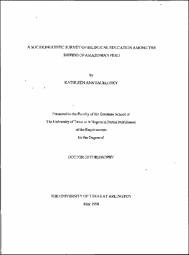
ATTENTION: The works hosted here are being migrated to a new repository that will consolidate resources, improve discoverability, and better show UTA's research impact on the global community. We will update authors as the migration progresses. Please see MavMatrix for more information.
Show simple item record
| dc.contributor.author | Tacelosky, Kathleen Ann | |
| dc.date.accessioned | 2020-10-07T20:28:58Z | |
| dc.date.available | 2020-10-07T20:28:58Z | |
| dc.date.issued | 1998-05 | |
| dc.identifier.uri | http://hdl.handle.net/10106/29471 | |
| dc.description.abstract | In the 1950s, the trend worldwide in public education was for classes to be conducted in the national (prestige) language. In Amazonian Peru however, an alternative was being considered: Bilingual Education (BE). Since monolingual education in Spanish in Peru had been unsuccessful, the government was looking for a way to educate indigenous Peruvians. Therefore, the government of Peru, together with the Summer Institute of Linguistics (SIL), implemented a BE program that incorporates vernacular indigenous languages and Spanish. The BE experiment was designed on a transition model: children are introduced to school and new concepts and skills such as reading in their mother tongue and then Spanish is introduced as a subject and eventually, as the medium of education. It is generally held that such a model has an ideology of assimilation and an objective of limited bilingualism (Skutnabb-Kangas and Phillipson 1995; Spener 1988). The response to and application of the BE program and linguistic and cultural factors that influence BE among one ethnolinguistic group of the Peruvian Amazon, the Shipibo, were investigated through the administration of oral survey interviews, observation and interaction with leaders, teachers, and students. Historical, social and political factors pertinent to the situation were also considered. The research is informed by and interpreted in light of a body of sociolinguistic literature which includes the study of language maintenance and language shift as well as a consideration of second language and literacy acquisition. Quantitative and qualitative analyses suggest that the situation among the Shipibo is in a relatively stable state of diglossia (Fishman 1972). That is, use of Spanish dominates in the written and formal spoken realm and Shipibo is used largely for conversation. Additionally, results show gender disparity in the outcomes of BE. The results indicate that in spite of an ideology and objectives that oppose maintenance of indigenous language and identity, due to their unique history and culture, and the value placed on vernacular languages by SIL, the Shipibo have maintained spoken Shipibo and a strong sense of identity. Suggestions for a model which embraces linguistic human rights by emphasizing language and cultural maintenance are offered. | en_US |
| dc.language.iso | en_US | en_US |
| dc.publisher | University of Texas at Arlington | en_US |
| dc.subject | Education | |
| dc.subject | Language | |
| dc.subject | Literature and linguistics | |
| dc.subject | Amazonian | |
| dc.subject | Bilingual | |
| dc.subject | Peru | |
| dc.subject | Shipibo | |
| dc.subject | Sociolinguistic | |
| dc.title | A SOCIOLINGUISTIC SURVEY OF BILINGUAL EDUCATION AMONG THE SHIPIBO OF AMAZONIAN PERU | en_US |
| dc.type | Dissertation | en_US |
| thesis.degree.department | Linguistics | |
| thesis.degree.name | Doctor of Philosophy in Linguistics | |
Files in this item
- Name:
- A Sociolinguistic Survey of ...
- Size:
- 9.809Mb
- Format:
- PDF
- Description:
- PDF
This item appears in the following Collection(s)
Show simple item record


